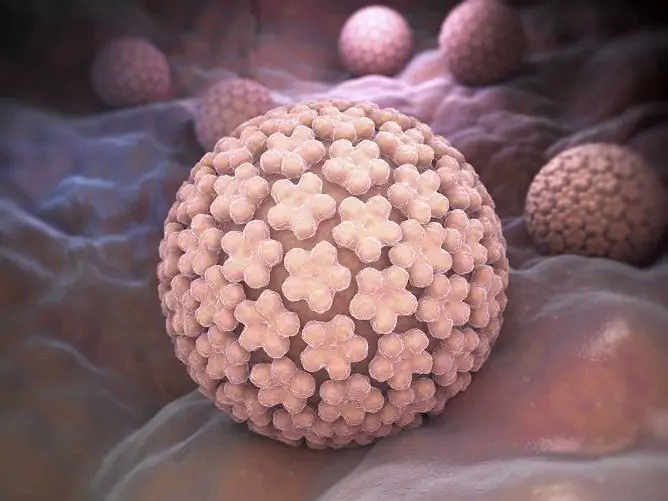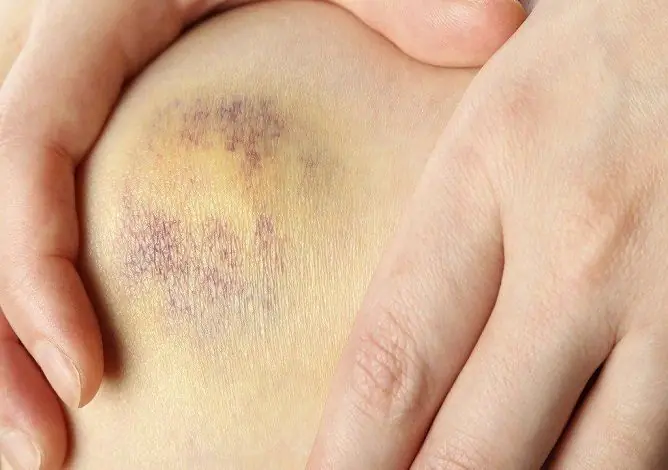- Author Rachel Wainwright [email protected].
- Public 2024-01-15 19:51.
- Last modified 2025-11-02 20:14.
Why do papillomas appear?
The content of the article:
- The reasons
-
Papillomavirus
HPV types and the formations they cause
- Factors predisposing to the onset of clinical symptoms
-
Doctor's advice in the fight against papillomas
- Treatment methods
- General recommendations
- Prevention
- Video
Papillomas are benign neoplasms of an infectious nature that arise in various areas of the skin and mucous membranes. It is difficult to establish specifically why papillomas appear, since both endogenous and exogenous causes lie in the pathogenesis of this disease. The immediate cause of the disease is the human papillomavirus (HPV, papillomavirus).

The main reason for the appearance of papillomas is an infection caused by the papillomavirus
The reasons
All causes of papillomas in various parts of the body and mucous membranes can be conditionally divided into three main groups:
- etiological;
- predisposing;
- accompanying.
As a rule, the occurrence of clinical manifestations will require the action of several factors simultaneously.
Papillomavirus
The etiological cause of the infection is the human papillomavirus.
Its characteristics:
- Belongs to the Papillomaviridae group.
- The DNA of a viral particle has three main zones: early (E), late (L) and upstream regulatory region (URR), and each of them has its own distinct function (for example, protein synthesis). After entering the cell, the envelope of the virus is destroyed and only this double-stranded DNA remains of it.
- It has a protein shell and is able to integrate into the host's DNA (this explains the impossibility of complete elimination of the pathogenic agent from the body). In the absence of predisposing factors, this pathological DNA is in a dormant mode, which is equivalent to a carrier or latent form of the disease (which is why screening studies of all population groups are required). In the case of activation of the viral complex and the start of the processes of transcription and replication, the disease goes into a subclinical or clinical form with typical external signs.
- During the replication of viral DNA, protein compounds are also formed that have a pronounced carcinogenic effect (the risk of malignancy for different forms is different, the greatest oncogenic danger is presented by papillomas of the cervix).
- The virus has a clear affinity for the corneal epithelium (hence the ability to infect any area of the skin that was in direct contact with a pathogenic agent), as well as a tropism for mucous membranes (explains the ability to infect the oral cavity, pharynx, larynx, cervix). Depending on this, a division into three large genera arises: alpha (affect the mucous membranes of the anogenital region), beta and gamma - have an affinity for the keratinizing epithelium.
- It multiplies in the basal layer of the epithelium (the focus grows from the inside out), but it is also determined in the remaining layers of the skin (a kind of pool of viral particles, from where self-infection or infection of another person can occur). In the blood, it is found in small quantities using the PCR reaction.
- It is relatively stable in the external environment, does not react to some disinfectants, and is thermostable.
- It has a weak immunostimulating effect (weak cellular and humoral response in response to the introduction of the pathogen) and therefore belongs to opportunistic agents. Immunity is formed only to a specific strain and does not protect against the likelihood of infection by a number of others.
- The main routes of infection are contact-household, sexual, vertical. This explains the presence of a viral agent in about 80-90% of the world's population.
The exact moment of infection and the duration of the disease is extremely difficult to establish, and for this reason, treatment is prescribed with a rather long delay.
The infection has no specific etiological treatment (sometimes antiherpetic drugs are used due to the similarity of the structure of the two viruses).
HPV types and the formations they cause
The papillomavirus has a large number of different serovars. The most complete classification is presented in the table (Villiers E. M., 1989).
| Clinical options (division site) | Species (strain) |
Skin lesions |
|
| Plantar warts | 1,2,4 |
| Common warts | 2, 4, 26, 27, 29, 57 |
| Flat warts | 3,10,28,49 |
| Butcher's warts | |
| Warty epidermodysplasia | 5, 8, 9, 10, 12, 15, 19, 36 |
| Non-warty skin lesions | 37.38 |
Lesions of the mucous membranes of the genitals |
|
| Condylomata accuminata | 6, 11.42-44.54 |
| Nonondylomatous lesions | 43, 51, 52, 55, 56, 57-59, 61, 64, 67-70 |
| Carcinoma | 16, 18, 31, 33, 35, 39, 45, 51, 52, 54, 56, 66, 68 |
Lesions of the mucous membranes of other organs |
|
| Laryngeal papilloma | 6, 11.30 |
| Carcinoma of the neck, tongue | 2.6, 11, 16, 18.30 |
Each specific given species is characterized by its own spectrum of predisposing or concomitant factors that trigger the process of dividing a viral particle (for example, promiscuous sexual intercourse increases the risk of HPV infection).
Types of formations depending on the affected area
| Localization | Types of neoplasms caused by HPV |
| Body (trunk, limbs, neck, armpits) | More common are vulgar, palmar-plantar, mosaic, cystic, flat and filamentous papillomas (this concept is synonymous with warts and condylomas, the differences are only in localization). |
| Anogenital zone | A warty, hyperplastic, or sedentary type of masses may appear, but the classic option for this area is genital warts. |
| Mucous membranes (cervix, oropharynx, larynx) | Pointed and flat neoplasms. |
The classical forms for different areas are given and each of them has its own clinical picture.
Factors predisposing to the onset of clinical symptoms
Under the influence of predisposing factors, the virus passes from a latent form to a manifest one, that is, symptoms of the disease appear. These factors include:
- Skin damage. For the penetration of a viral particle, it is enough to slightly scratch the skin or abrasion (exposure of the basal layer).
- Violation of immunity. People with immunodeficiency (in particular, HIV-infected people), people with chronic or often recurrent infectious diseases are especially vulnerable. In this case, the depletion of the immune system occurs and the viral DNA is activated, which leads to the development of pathology.
- Taking a number of drugs, such as immunosuppressants, in cancer patients that suppress the normal immune response. For the same reason, persons who have undergone serious surgical interventions (especially transplants) and are taking immunosuppressants are vulnerable.
- Disruption of the normal functioning of the hormonal systems. In particular, diabetes mellitus leads to a total disruption of metabolic processes in tissues.
- External factors (chemical, physical). At the same time, they affect the functioning of the immune system and the barrier functions of the skin.
- Inappropriate clothing, which leads to chafing of the skin and the formation of shallow defects (gateway for the virus). And also this group includes clothing made of synthetic fabrics and the exchange of wardrobe items with the carrier of the virus.
- Violation of hygiene rules and lack of personal hygiene products (shared razors, towels with a potential carrier of the virus).
- Frequent stress, chronic fatigue syndrome leads to a decrease in the body's defenses.
- Violation of the rules of a healthy lifestyle (unhealthy diet, physical inactivity) leads to a slowdown in metabolic processes and reduces the functioning of the immune system.
Some of the specific causes for specific affected areas are shown in the table.
| Zone | Predisposing factors |
| Axillary area | Excessive sweating, use of contaminated shaving razors (poor hygiene). |
| Anogenital area | The prerequisites are the same for both men and women: frequent change of sexual partners, early onset of an intimate life, refusal of barrier contraception, frequent infections of the urinary system. |
| Oral mucosa | Injury from crowns, dentures, or deformed and chipped teeth; dysbacteriosis with a predominance of opportunistic flora, eating too hot or spicy food (also increases the risk of malignant tumors that mimic typical papillomas), kissing a carrier, oral sex, using common personal hygiene items with a carrier (toothbrush, for example). |
Specialists will treat papillomas, regardless of the specific reason, according to one comprehensive scheme, to which minor adjustments can be made.
Doctor's advice in the fight against papillomas
If formations appear on the body, consultation of a doctor - dermatovenerologist, and sometimes an oncologist is required, since benign and malignant skin growths can be outwardly similar.
Treatment methods
Depending on the localization, one of the most relevant methods of treatment is chosen (destructive physical or chemical effects, as well as local cauterizing agents), but in essence they have a similar mechanism of action, causing protein denaturation and allowing to get rid of the focus.
Isolated methods of destruction allow you to deal with the appearance of small single growths. In the case of often recurrent or total lesions that involve several anatomical regions at once, the introduction of immunostimulants is shown to enhance the immune response.
Papillomas appear on the body due to viral infection, therefore, antiviral agents of local and systemic action are used.
Due to the risk of degeneration or for aesthetic reasons, the formation is removed, especially in places that are amenable to constant friction (neck, groin and axillary area). You should not try to do this yourself, since the risk of infection is very high.

It is necessary that the skin lesions caused by HPV are removed by a doctor
General recommendations
In the fight against papillomas, it is important to maintain the normal functioning of the immune system. This recommendation is feasible by following the rules of a healthy lifestyle:
- proper nutrition;
- moderate and regular physical activity;
- full sleep;
- observance of the regime of work and rest.
Prevention
To reduce the risk of developing cervical cancer, women are shown preventive vaccination, which is carried out before sexual activity (it is recommended to start vaccination at 10-13 years old). Since oncogenic HPV strains can cause a number of malignant tumors in men, vaccination is also indicated for them. For this purpose, a bivalent and quadrivalent vaccine is used.
In addition, it is recommended:
- Compliance with the rules of hygiene, individual use of towels, razors and other hygiene items. When visiting common areas (gym, swimming pool), wearing individual changeable shoes.
- Use of barrier methods of contraception and healthy sex life (one partner).
After a laboratory and clinically recorded case of papillomas, observation by a dermatovenerologist is required once a year to monitor the activity of the virus. If desired, anyone can donate blood for testing at a private or public medical institution.
Video
We offer for viewing a video on the topic of the article.

Anna Kozlova Medical journalist About the author
Education: Rostov State Medical University, specialty "General Medicine".
Found a mistake in the text? Select it and press Ctrl + Enter.






